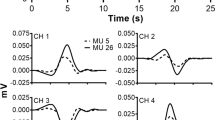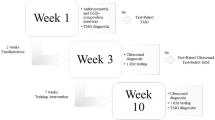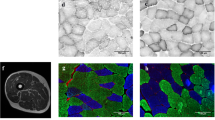Abstract
The purpose of this investigation was to determine whether 12 weeks of resistance training, which increased arm girth (5%) and forearm extensor strength (39%), also altered the myosin heavy chain (MHC) characteristics of the triceps brachii muscle. Fifteen healthy, active men volunteered to participate under experimental (n = 11) or control (n = 4) conditions. The experimental group completed four sets of eight to 12 repetitions for each exercise (i.e. triceps pushdown, close grip bench press, triceps kickbacks and biceps curl) with loads of between 70–75% of one repetition maximum (1RM) three times a week. The inter-set and inter-exercise recovery period was only 90 s. Skeletal muscle tissue was removed from the triceps brachii muscle prior to (W0) and following 4 (W4), 8 (W8) and 12 (W12) weeks of the investigation. Samples were analysed for MHC isoform content using 6% sodium dodecyl sulphate-polyacrylamide gel electrophoresis (SDS-PAGE). MHC isoform composition in the control group did not change significantly. However, the percentage of MHC type IIb isoform decreased significantly from W0 to W4 and again from W4 to W12 [W0: 39.7 (9.2); W12: 29.2 (8.2)%] in the experimental condition. The increments in MHC type IIa [W0: 34.0 (9.9); W12: 41.5 (10.4)] and type I [W0: 26.3 (7.9); W12: 29.3 (9.6)] isoforms were not significant for the experimental group. However, the effect size (ES) transformation of changes in types IIa MHC content was moderate (ES = 0.75). Changes in MHC isoform content were not significantly correlated with changes in 1RM strength for the triceps pushdown exercise. These data indicated that resistance training rapidly, and in an ongoing manner, changed the contractile protein profile of trained skeletal muscle. However, changes in MHC isoform composition in the first 12 weeks of training were not implicated in the development of 1RM triceps pushdown strength.
Similar content being viewed by others
References
Abernethy PJ, Jurimae J, Logan PA, Taylor AW, Thayer RE (1994) The acute and chronic responses of skeletal muscle to resistance exercise: a review. Sports Med 17:22–38
Abernethy PJ, Jürimäe J (1996) Cross-sectional and longitudinal uses of isoinertial, isometric and isokinetic dynamometry. Med Sci Sports Exerc (in press)
Adams GR, Hather BM, Baldwin KM, Dudley GA (1993) Skeletal muscle myosin heavy chain composition and resistance training. J Appl Physiol 74:911–915
Andersen JL, Klitgaard H, Bangsbo J, Saltin B (1994) Myosin heavy chain isoforms in single fibres from m. vastus lateralis of soccer players: effect of strength training. Acta Physiol Scand 150:21–26
Baker D, Wilson G, Carlyon B (1994) Generality versus specificity: a comparison of dynamic and isometric measures of strength and speed-strength. Eur J Appl Physiol 68:350–355
Bergstrom J (1962) Muscle electrolytes in man. Scand J Clin Lab Invest 14 [Suppl 68]:1–110
Biral D, Betto R, Danieli-Betto D, Salviati G (1988) Myosin heavy chain composition of single fibres from normal human muscle. Biochem J 250:307–308
Blomstrand E, Ekblom B (1982) The needle biopsy technique for fibre type determination in human skeletal muscle — a methodological study. Acta Physiol Scand 116:437–442
Bottinelli R, Sandoli D, Canepari M, Reggiani C (1992) Maximal isometric force and myosin heavy chain isoform composition in single skinned skeletal muscle fibres from the rat. Pflügers Arch 420:R193
Caiozzo VJ, Haddad F, Baker MJ, Baldwin KM (1994) The influence of mechanical loading upon myosin heavy chain protein and mRNA isoform expression: a time course study. Med Sci Sports Exerc 26:S91
Chesley A, MacDougall JD, Tarnapolsky MA, Atkinson SA, Smith K (1992) Changes in human protein synthesis after resistance exercise. J Appl Physiol 73:1383–1388
Cohen J (1969) Statistical power analysis for the behavioural sciences. Academic Press, New York
Costill DL, Coyle EF, Fink WF, Lesmes GR, Wiltzmann S (1979) Adaptations in skeletal muscle following strength training. J Appl Physiol 46:96–99
Danieli-Betto D, Zerbato E, Betto R (1986) Type 1, 2A and 2B myosin heavy chain electrophoretic analysis of rat muscle fibres. Biochem Biophys Res Commun 138:981–987
Fry AC, Allemeier CA, Staron RS (1994) Correlation between percentage fibre type area and myosin heavy chain content in human skeletal muscle. Eur J Appl Physiol 68:246–251
Goldspink G, Scutt A, Martindale J, Jaenicke T, Turay L, Gerlach GP (1991) Stretch and force generation induce rapid hypertrophy and myosin isoform gene switching in adult skeletal muscle. Biochem Soc Trans 19:368–373
Gregory P, Gagnon J, Essig DA, Reid SK, Prior G, Zak R (1990) Differential regulation of actin and myosin isoenzyme synthesis in functionally overloaded skeletal muscle. Biochem J 265:525–532
Houston ME, Frose EA, Valeriote SP, Green HJ, Ranney DA (1983) Muscle performance, morphology and metabolic capacity during strength training and detraining: a one leg model. Eur J Appl Physiol 51:25–35
Karapondo D, Staron R, Hagerman F (1991) The time course for fast-twitch fiber type conversions in resistance trained men and women. Med Sci Sports Exerc 23:S130
Klitgaard H, Mantoni M, Schiaffino S, Ausoni S, Gorza L, Laurent-Winter C, Schnohr P, Saltin B (1990) Function, morphology and protein expression of aging skeletal muscle: a cross-sectional study of elderly men with different training backgrounds. Acta Physiol Scand 140:41–54
Komi PV (1986) Training of muscle strength and power: interaction of neuromotoric, hypertrophic, and mechanical factors. Int J Sports Med 7:10–15
Kraemer WJ, Patton JF, Gordon SE, Harman EA, Deschenes MR, Reynolds K, Newton RJ, Triplett NT, Dziados JE (1995) Compatability of high-intensity strength and endurance training on hormonal and skeletal muscle adaptions. J Applied Physiol 78:976–989
Larsson L, Tesch PA (1986) Motor unit fibre density in extremely hypertrophied skeletal muscle in men: muscle electrophysiological signs of fibre hyperplasia. Eur J Appl Physiol 55:130–136
MacDougall JD, Sale DG, Elder GCB, Sutton JR (1982) Muscle ultrastructural characteristics of elite powerlifters and bodybuilders. Eur J Appl Physiol 48:117–126
MacDougall JD (1992) Hypertrophy or hyperplasia. In: Komi PV (ed) Strength and power in sport. The encyclopedia of sports medicine. Blackwell Scientific Publications, Oxford, pp 230–238
Maughan RJ (1984) Relationship between muscle strength and muscle cross-sectional area. Implications for training. Sports Med 1:263–269
McDonagh MJV, Davies CTM (1984) Adaptive response of mammalian skeletal muscle to exercise with high loads. Eur J Appl Physiol 52:139–155
Moritani T, deVries HA (1979) Neural factors versus hypertrophy in the course of muscle strength gain. Am J Phys Med 57:263–277
Moritani T (1991) Time course adaptations during strength and power training. In: Komi PV (ed) Strength and power in sport. The encyclopedia of sports medicine. Oxford, pp 249–265
Nygaard E, Houston M, Suzuki Y, Jorgensen K, Saltin B (1983) Morphology of the biceps brachii muscle and elbow flexion in man. Acta Physiol Scand 117:287–292
Ploutz LL, Tesch PA, Biro RL, Dudley GA (1994) Effect of resistance training on muscle use during exercise. J Appl Physiol 76:1675–1681
Roman WJ, Fleckenstein J, Stray-Gundersen J, Alway SE, Peschock R, Gonyea WJ (1993) Adaptations in the elbow flexors of elderly males after heavy-resistance training. J Appl Physiol 74:750–754
Sale DG (1988) Neural adaptations to resistance training. Med Sci Sports Exerc 20:S135-S145
Siegel G (1956) Non parametric statistics for the behavioural sciences. McGraw-Hill, New York
Staron RS, Malicky ES, Leonardi MJ, Falkel JE, Hagerman FC, Dudley GA (1990) Muscle hypertrophy and fast fibre type conversions in heavy-resistance-trained women. Eur J Appl Physiol 60:71–79
Staron RS, Leonardi MJ, Karapondo DL, Malicky ES, Falkel JE, Hagerman FC, Hikida RS (1991) Strength and skeletal muscle adaptations in heavy-resistance-trained women after detraining and retraining. J Appl Physiol 70:631–640
Staron RS, Karapondo DL, Kraemer WJ, Fry AC, Gordon SE, Falkel JE, Hagerman FC, Hikida RS (1994) Skeletal muscle adaptations during early phase of heavy-resistance training in men and women. J Appl Physiol 76:1247–1255
Tesch PA, Wright JE, Daniels WL, Sjodin B (1983) Physical performance and muscle metabolic characteristics. In: Knuttgen HG, Vogel JA, Poortmans J (eds) Biochemistry of exercise. Human Kinetics, Champaign, pp 258–263
Tesch PA (1991) Training for bodybuilding. In: Komi PV (ed) Strength and power in sport. The encyclopedia of sports medicine. Oxford, pp 370–380
Thomas JR, Salazar W, Landers DM (1991) What is missing in p <.05? Effect size. Res Q Exerc Sport 62:344–348
Viru A (1987) Mobilisation of structural proteins during exercise. Sports Med 4:95–128
Wang N, Hikida RS, Staron RS, Simoneau JA (1993) Muscle fibre types of women after resistance training — quantitative ultrastructure and enzyme activity. Pflügers Arch 424:1494–502
Author information
Authors and Affiliations
About this article
Cite this article
Jürimäe, J., Abernethy, P.J., Blake, K. et al. Changes in the myosin heavy chain isoform profile of the triceps brachii muscle following 12 weeks of resistance training. Europ. J. Appl. Physiol. 74, 287–292 (1996). https://doi.org/10.1007/BF00377452
Accepted:
Issue Date:
DOI: https://doi.org/10.1007/BF00377452




